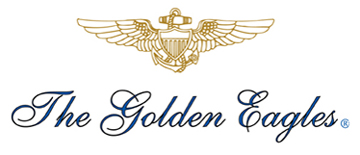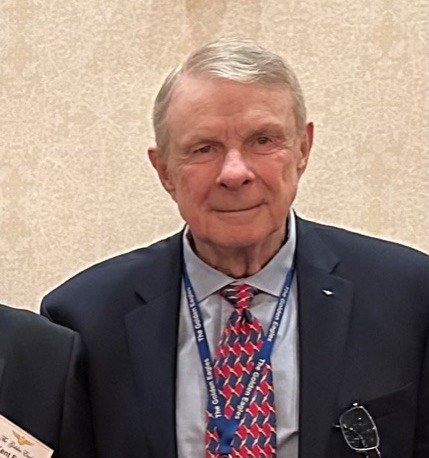Captain J. Richard Brown, USN (Ret), Golden Eagle
Gentlemen,
It is my sad duty to inform you that in the afternoon of Wednesday, 15 January 2025, Golden Eagle CDR J. Richard BROWN, USN (Ret), made his Last Take Off in his home city of Richmond, Virginia. He was in the intensive care unit of the local hospital fighting complications that developed while addressing gall bladder issues.
Known throughout Naval Aviation as “Hot Dog,” he was born in Davenport, Iowa, and then spent his early years in Norman, Oklahoma. The family then moved to Princeton, Illinois, where he graduated from Princeton High School in 1956. On graduation, Hot Dog enlisted in the Navy, reporting to Navy Recruit Training, Great Lakes, IL, in June 1956. On completing boot camp, he reported to Dam Neck, VA, for further training at the U.S. Navy Guided Missile School, finishing in October 1957, as a Petty Officer Third Class. He then attended the Naval Academy Preparatory School in Bainbridge, MD, was a company commander, and graduated in June 1958. He then directly reported to the U.S. Naval Academy for his four years on the Severn, graduating on 6 June 1962.
Ensign BROWN next reported to Pensacola, FL, in July 1962 to begin his Naval Aviation career. While in flight training, he flew the T-34 Mentor, T-2C Buckeye, F-9F Panther, and the F-11F Tiger, earning his Wings of Gold on 25 September 1963. NAS Miramar, San Diego, CA, was his next duty assignment, joining the F-8 replacement air group (RAG), VF-124, for instruction in the Crusader, flying the F-8A/C/D/E. Hot Dog’s first fleet assignment was with VF-111, flying the F-8D. He joined the squadron mid-deployment, in April 1964, deployed on USS Kitty Hawk (CVA 63) in the South China Sea. This was the period just prior to the Gulf of Tonkin incident in August 1964, but flights over land were being targeted. Returning to the United States in July 1964, VF-111 transferred to USS Midway (CVA 41), deploying again to Vietnam from April–November 1965. During that period, VF-111 lost four aircraft to enemy fire, with only one survivor. During these two deployments Hot Dog earned full landing signal officer (LSO) qualifications. Leaving VF-111 in January 1966 since he was “combat limited” (only two combat deployments allowed at the time), Hot Dog reported to VF-13 in February, flying the F-8E and D, deployed aboard USS Shangri-La (CVA 38), and again serving as an LSO. He completed half a Mediterranean Sea deployment before reporting to the training command, VT-22, in April 1967. While there he was FAM phase leader, Tactics phase leader, and LSO, flying the TF-9J and AF-9J.
Hot Dog left the Navy in March 1968 and joined Sundstrand Aviation as a Lead Applications Engineer, working on the F-14 wing sweep system, the L-1011 flaps and slats actuation system development and the DC-10 flap/slats actuation systems. He returned to the Navy in September 1969, joining VF-124 at NAS Miramar as an instructor in tactics and as the senior LSO, flying the F-8H/J and the T-39D Sabreliner. His following assignment was to Carrier Air Wing Five (CVW-5) as CAG LSO in October 1970, again deployed on USS Midway. While there he completed two combat deployments to Vietnam, flying the F-4B Phantom II and the A-6A Intruder. He also managed to fly several combat missions with the U.S. Army in an OH-6A “Loach” and the U.S. Marine Corps in an OV-10 Bronco. At the completion of his tour in CVW-5, in November 1972 he reported to NAF China Lake as a Flight test pilot. This turned out to be a relatively short tour due to his selection to attend the U.S. Naval Test Pilot School in Patuxent River, MD, reporting there in July 1973. Flying the numerous aircraft that students typically fly there, his assignment on graduation was to Head, Fighter Programs Flight Test, Pacific Missile Test Center (PMTC), Pt. Mugu, CA, reporting in June 1974.
Stationed at PMTC for over two and a half years, Hot Dog flew the F-4B, F-4J, A-7A Corsair II, TA-4J Skyhawk, F-14A Tomcat, P-3A Orion, and the NF-4J. He fired the first AIM-9L from an A-7, 11 AIM-54 Phoenix missiles from the Tomcat, and assisted in pioneering the introduction of advanced helmet acquisition/helmet mounted displays. He also led the first direct ferry of two Iranian F-14s from Beth Page, NY, to Esfahan, Iran. This probably led to his next assignment, in February 1977, as Commander for the introduction team that provided the flight and maintenance training for the Iranian air force F-14s in Shiraz Air Base, Iran. Responsible for over 500 plus American contractors, Hot Dog worked this job for 14 months before returning to the states in May 1978. Assigned to Naval Air Systems Command (NAVAIR) as the deputy program manager for the F-14 and deputy program manager for foreign military sales. In September 1978 he had the unpleasant task of shutting down the Iranian F-14 program when Iran defaulted on F-14 contracts. Hot Dog had to terminate all the contracts and was responsible for the evacuation of all F-14 military and civilian personnel from Esfahan — which certainly must have had some “exciting” moments. He concluded his active-duty career at NAVAIR, retiring in November 1981.
Over his Navy career, Hot Dog accumulated over 2,800 flight hours, 501 carrier arrested landings, and made four combat deployments to the waters off Vietnam, flying 243 combat missions. He was awarded nine individual Air Medals, eleven Strike/Flight Air Medals, and three Navy Commendation Medals with Combat “V,” in addition to individual and unit awards. As evident in the listing of aircraft above, which was not all inclusive, he flew numerous types/models of aircraft in combat and in flight test regimes, paving the way for others to follow.
On retirement from the Navy, Hot Dog founded and was President of Whitney, Bradley & Brown, Inc. (WBB) a defense consulting company that he grew from inception to a more than 90-million-dollar, award winning entity, that worked on many Navy and Defense Department advanced programs. Leaving the company in 2001, he remained active by joining Rumpf Associates International as an associate, owned Rick’s Wine and Gourmet shop in Alexandria, VA, through 2015, and in 2014 became a partner with Piranha Analytics. He was also a member of the Society of Experimental Test Pilots, joining in 1975, and served as the President of the National Aeronautical Association. Even with this full professional life, Hot Dog made time to serve his community, serving as treasurer of the St. Francis Episcopal Church Vestry, as director of its youth group, and was a board member of the Great Falls Athletic Association and basketball official for Virginia high school basketball.
It would be an understatement to say that Hot Dog loved to fly. Throughout his career he remained in the cockpit, flying in combat and the world of test flight, and flying from the LSO platform, where he provided the calm voice to help bring home to “Mother” those who were experiencing a “night in the barrel.” In his active career and in his follow-on professional life, Hot Dog had a direct, and large, impact on many aspects of Naval Aviation, including weapons test, weapons system integration, aircraft requirements development, aircraft carrier requirements development, and many other programs. Naval aviation was most fortunate to have him.
Hot Dog married the love of his life, Nora Lee, in 1984. He is survived by Nora Lee, his children Whitney, Bradley, Michael, and Kevin, and by eight grandchildren. Services are pending, with that information to be provided in a Special Notice when it is available.
He will be missed. |

